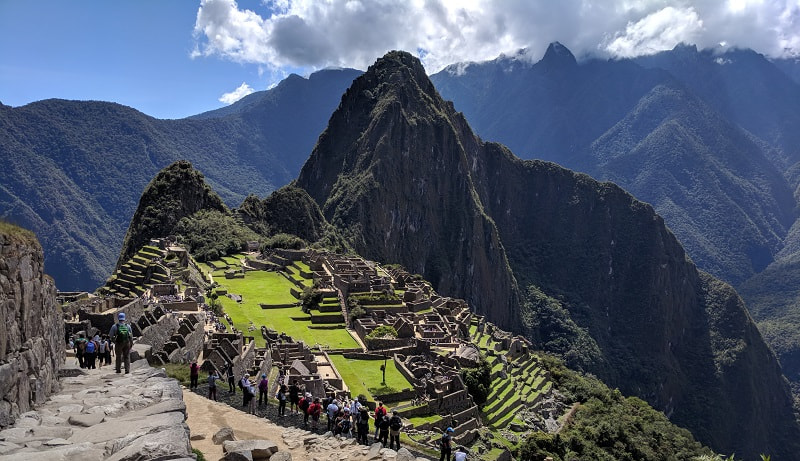
This is one of those once in a lifetime days that will be costly, but it is a must for most people visiting Peru. Our bus, train, accommodations, and entrance were all included in our trek tour price, but I list the options and cost below. You must purchase train tickets, Machu Picchu entry tickets, trekking tours, and optional mountain tickets ahead of time. These sell out and if you just show up you are likely to be disappointed.
There is no time like now to go on any trip but this is particularly true of Machu Picchu. As human impact, erosion, and earthquakes threaten the site, new rules are being made to preserve it by restricting visitors; such as now you can only visit for half a day. They say that the Incas engineered the stones to dance in earthquakes but who knows for how long they can stand if the ground below them fails.
You can see my Itinerary Post for details on our full trip, a budget, and how many miles/flights of stairs my FitBit said I did each day.
Getting from Aguas Calientes to Machu Picchu
The first thing you need to decide is how to get up the mountain.
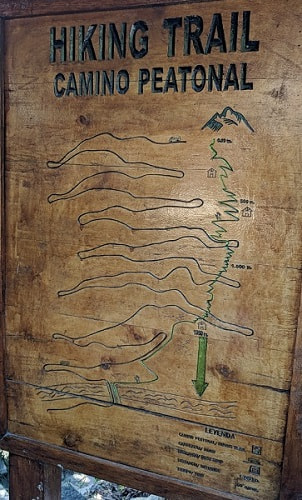
Walk/climb
-
Free
-
Most of the trail is very steep stairs that cross the road several times
-
If you want to get to Machu Picchu at sunrise you will be climbing in complete darkness with a headlight
-
The climb may take less time than waiting for the bus at peak times
-
The climb may wear you out (if you are climbing a mountain you might not want to do this)
-
If you want to do this I recommend reading this post from The Only Peru Guide
Bus
-
$12 each way/$24 round trip
-
Trip takes about 30 minutes
-
Line to get on the bus can take a very long time. We lined up a little after 4AM to catch the bus and the line was already across town. For the ride back down we waited in the sun for over 45 minutes.
Since there is no savings for round trip ticket you don’t loose anything by walking one way and riding the other.
When to go
You have the choice of visiting Machu Picchu in the morning group or the afternoon group.
Morning - This is when we went and what I would recommend
-
Much cooler temperature (in May we needed a sweater in the morning, but by noon we were down to t-shirts and still dripping sweat)
-
Lots of cloud cover, which can be a plus and a minus, but it usually clears by mid-day
-
You have to stay in Aguas Calientes
-
The wait for the bus is very long if you want to go up right when the gates open
Afternoon
-
Very hot and very little shade
-
Usually fairly clear (at least in the dry season)
-
You have the option of staying in Hyrdroelectrica or Ollantaytambo and take the train in for the day
-
You can sleep in and won’t be lining up for the bus in the dark
Machu Picchu Experience
We got up long before dawn and our tour had arranged for an early breakfast at our hotel so we could get to the bus line early. We got in a line that already stretched across town a little after 4:00 AM and waited for 5:30 AM when the buses would start running. The buses were nice coach buses with bucket seats and air conditioning. At the gate we got in the very long bathroom line since the only bathroom is outside the site. Then we got in the entry line around 6:30 AM.
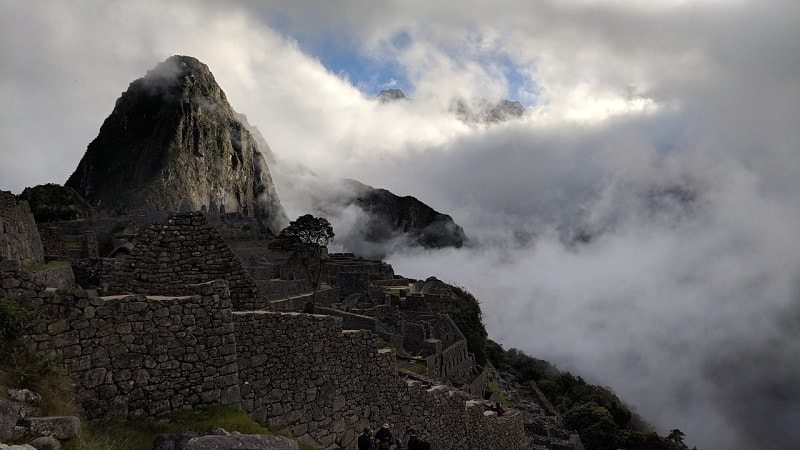
Inside the citadel the sun was up but still obscured by the clouds. As we walked the clouds swirled around Wayna Picchu, invisible one moment, then suddenly appearing, and gone the next. It was surreal watching the mountains and valley below gradually appear through the mist. A bit after 8:00 AM most of the clouds finally cleared.
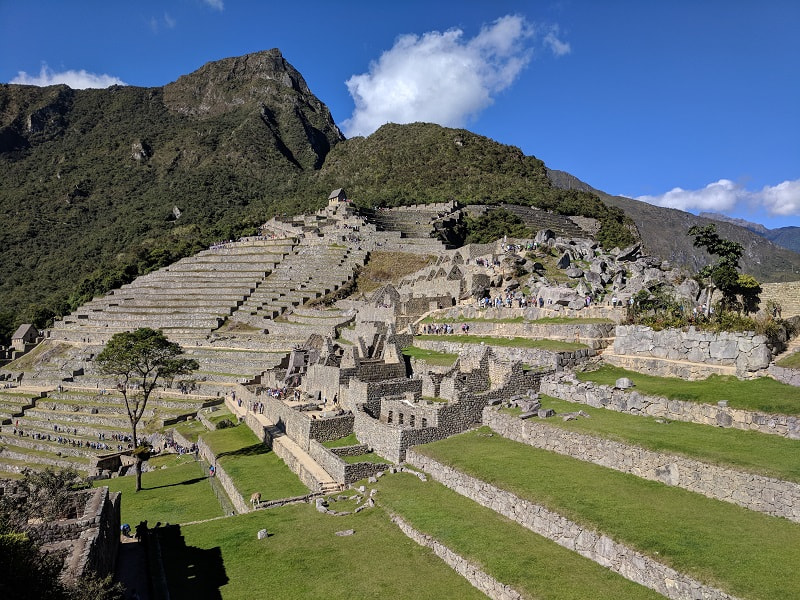
Our guide explained the architecture and history of what we were seeing. He told us how the Spanish were unable to find the citadel because when they invaded the Incas abandoned it, presumably to save it, and how the slaves that built it could not locate it because they were brought here blindfolded or in the fog. One story that I had never heard was of the gladiatorial games that were played here. One team would be the warriors and they would have armor and weapons, and would be executed if they lost. The other team would be unarmed slaves and prisoners, with the promise of freedom if they won. The goal was to score by getting a squash on a pole at the opponent’s end of the field.
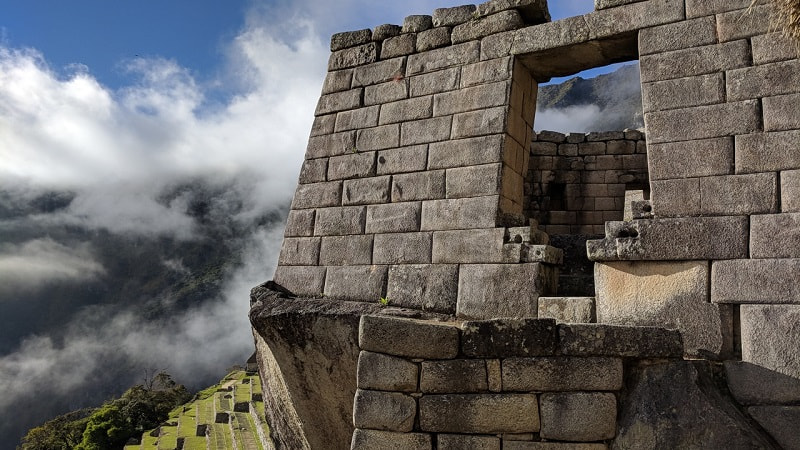
As we walked out we spotted the dog that had followed our group for the entire journey, just as he was snagging a piece one of Peru’s most expensive sandwiches from the Machu Picchu Restaurant. We stood in line again (about 20 minutes this time) to use the bathroom, then rushed to the trailhead to climb Machu Picchu Mountain (more on that below).
After our climb we got in line to get our free Machu Picchu passport stamp and joined the bus queue. The line for the bus took about 45 minutes. This day was a great experience, but between standing in line and the bus rides we felt that we spent more time waiting than seeing, and after days of trekking in solitude the crowds were a bit much. Many people liken the experience to a theme park, and while it was far from that I do recognize some of the similarities. We felt like this day was a big game of hurry up and wait, without much time for reflection or savoring anything.
For the story of how Machu Picchu has faded in and out of the jungle over the centuries and how it was discovered and rediscovered I recommend Turn Right at Machu Picchu by Mark Adams. He artfully combines history and his own midlife crisis adventure retracing Bingham’s steps. It is a great narrative with a nice mix of culture and humor.
The Expedition Train Experience
We grabbed some lunch in town, bought a slice of banana bread from a lady near the train, and got on the Expedition Train to Poroy. The train was very nice with big windows on the sides and top to look out. Most seats were in sets of 4 facing each other with a shared table. Seats were assigned. The table was narrow making legroom a bit tight without bumping knees and feet. They served complementary beverages and snacks a couple times and came around with carts of trinkets and additional snacks for purchase.
This is said to be one of the world’s slowest trains and I believe it. It varied in speed, but most of the time I think we could have walked faster. We had plenty of time to watch the landscape go by. At one point the train stopped and a conductor hopped out and laid down on the ground looking at the tracks, then got up, put a hand on the train, and started walking along with it very slowly. We joked that he was pushing it. He walked along the train like this for at least ten minutes, before hopping back on.
Optional Mountain Climbs
To climb Machu Picchu Mountain or Wayna Picchu Mountain (also known as Huayna Picchu) is the big question, or do you skip it and spend more time exploring the citadel? It is a hard call. If you don’t do one of these you will have more time in the citadel or there are other optional free hikes like the Sun Gate and the Inca Bridge (the Inca’s version of a drawbridge).
Some Considerations:
-
When? - There are two time slots for each. The earlier one will give you much cooler temperatures and some cool fog, but there may be so much cloud cover that you can’t see down at all. The second time slot will give you a better chance of an unobstructed view but will be much hotter.
-
Tickets - For Wayna Picchu tickets tend to sell out months in advance so you will need to book early to do this one. Machu Picchu is a little less popular, but still sells out so you will want to get tickets at least a few weeks before. See Cost for prices.
-
A little more time - Climbing does extend your ticket and give you a little more time in the citadel (at least as of 2018), but most of this time is used on the hike.
-
Heights - Both trails are steep and have some serious drop offs, so if you have a fear of heights this may not be for you.
-
Strenuous & Moderately Risky - Both trails have lots of steep stairs with two way traffic and can be dangerous. If you have not acclimated to the altitude yet you may also have trouble breathing and experience altitude sickness.
-
Crowds - Both mountains have a limited number of tickets, but both generally sell out so these trails will be crowded. Do not expect to find solitude here.
-
Machu Picchu Mountain is bigger and has a better view of the surrounding area. The hike is longer, and mostly straight up. The first half of the trail has tree cover, but the second half is completely exposed. The view of Machu Picchu from the top is the classic view you see with Wayna Picchu behind it, but from far away. I think the better picture is from just above the guardhouse. If you did the Salkantay or Inca Trail it is cool to be able to look down and see where you walked.
-
Wayna Picchu Mountain is a smaller mountain and shorter hike. It is known for narrow stairs and steep drops. Some of the trail requires climbing on all fours and in one spot you have to crawl though a small area. In addition to the view from the top, this mountain has a cave with the ruins of the Moon Temple.
-
Making the Choice - As I’ve only done one of these hikes it is hard to say which is better, but I found that Ticket Machu Picchu and Detour both have good articles to help pick between the two mountains.
Climbing Machu Picchu Mountain
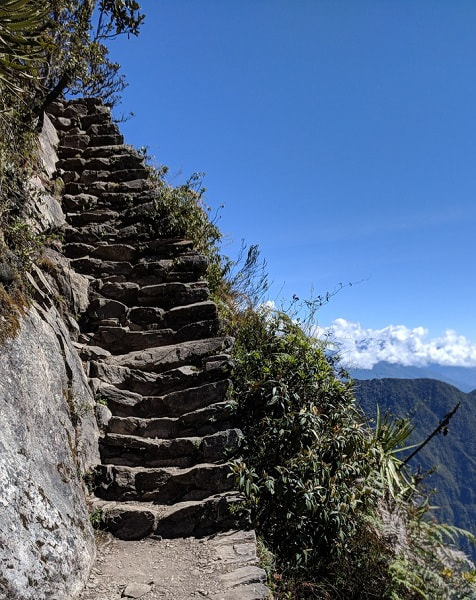
Climbing this mountain was in no way technically difficult, but did take a lot of stamina and bit of mental concentration because the stairs were steep and uneven. We were somewhere in the middle of the 400 people climbing in the second group so there was nearly constant traffic going both ways, and in many places a solid line of people hiking up single file. It was hot and humid, but when the trees started to thin out and the trail was exposed to the sun it got brutally hot. The occasional whisper of a breeze was welcome, but far too infrequent. This is still over 8,000 ft, but just barely, and after doing the trek (15,000 ft) the breathing felt relatively easy, but our bodies were tired from 4 days of hiking. It took us about 2.5 hours from the check point to go up and down (about 1.5 to get to the top, .5 at the top, and .5 going back down).
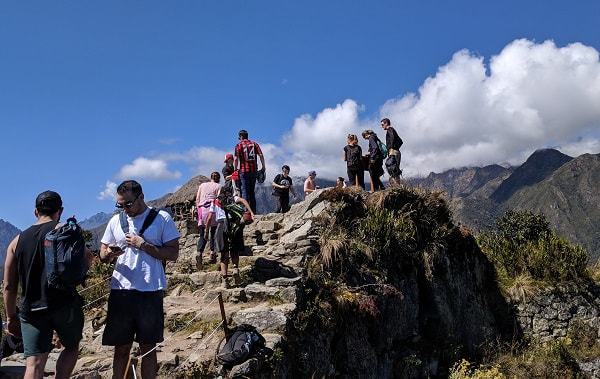
The top was roped off all the way around to keep people away from the edge. It had a covered area where you could get out of the sun and enjoy the nice breeze. It was quite crowded and was one of those places where you wait in line to get your turn against the railing for a picture. The view of Machu Picchu was nice, but the view of the surrounding area was really the prize. After doing the trek it was really rewarding to look back at Salkantay Peak (clouds permitting) and see how far we came.
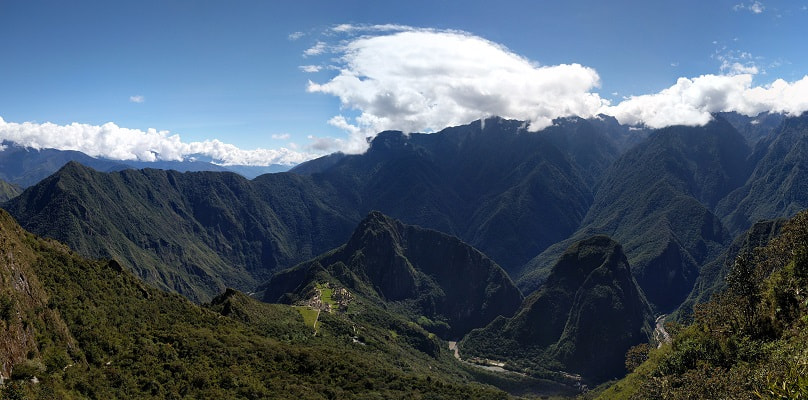
Overall I would say the heat was the most difficult part of this hike. For me the crowds were frustrating and more than I was expecting. If I had to choose again I probably would have done Wayna Picchu or spent more time in the citadel; however, it does makes for pretty good bragging rights to do the bigger mountain.
Rules
The rules change frequently so please double check before you go. These are the rules as of spring 2018 when we were there.
A few of the important rules and our perception of enforcement:
-
No hiking poles unless you are disabled (This is to protect the site but did not seem to be well enforced. We saw many come out of backpacks on the mountain trails and we wish that we had ours on the steep stairs.)
-
No food (If it is in your bag, you don’t make a mess, and you don’t setup a picnic no one cares. Food is very expensive to buy there so I recommend bringing at least a snack.)
-
No beverage (Do not bring alcohol but you must bring water, you will need it.)
-
No professional cameras, selfie sticks or tripods (They seem very lenient on all of these as long as you don’t push it. Keep your camera in your bag when going through the gate. There are licenses available for professional cameras but it is hard to say where to draw the line for what counts. The biggest thing is to be respectful of the site and other people.)
-
No sitting on or climbing on the walls
-
No bags larger than 20L (This was somewhat enforced at the gate and there was rentable storage outside. Cost below.)
-
No re-entry (We went with our tour guide and we were permitted to do a second circuit or walk to the sun gate.)
-
No entry without a local guide (We went with a guide. They seemed somewhat lenient on this, and supposedly there has been a shortage of licensed guides, but you will get a lot more out of the experience with a guide. There are not signs explaining things here.)
-
Stay on the path (They are very strict about not going the wrong way and no going backwards.)
Fines and Penalties - While these may not have all been enforced when we were there they could be at any time. If you break the rules you can be kicked out of the site, and in some cases fined, so use your judgment. Please be respectful. This is a once in a lifetime experience for most and a holy site.
Adventure Smith Explorations has a great comprehensive list.
Cost
The price you pay does have a number of fixed items, but quite a bit is variable. Here are approximate costs as of spring 2018:
-
$.60 (2 soles) per person to use the bathroom (this is a crowded and controlled area, so no you can not just go in the woods)
-
$70 Machu Picchu entry (less for students, children, & nationals)
-
$15 Optional mountain climb (our tour company charged us $35)
-
$75 Train each way (price varies, see Peru Rail for tickets and prices. You can go via Santa Teresa or Hyroelectrica instead, but only in the dry season)
-
$12 Bus each way to and from between Machu Picchu and Aguas Calientes (or you can hike up)
-
$2 (5 soles) for bag storage next to the bathroom (many hotels in town will store things for you but they also often charge)
-
$20-$200 Hotel/Hostel in Agaus Calientes ($20 would be for a hostel per person. Some people stay in Santa Teresa or Hydroelectica instead.)
-
$20-$40 for food for a day in town (food is expensive in Aguas Calientes)